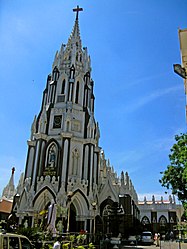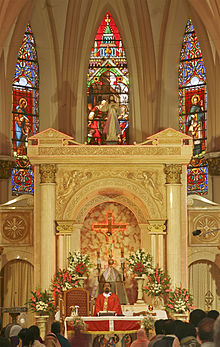St. Mary's Basilica, Bangalore
St. Mary's Basilica is a basilica located in theArchdiocese of Bangalore in the Indian stateof Karnataka. It is the oldest church inBangalore and is the only church in the state that has been elevated to the status of aminor basilica.[1][2] [3] It is famous for the festivities held during the St. Mary's Feast in the month of September each year, an event that attracts a number of devotees from in and around Bangalore.
History
St. Mary's Basilica had a humble beginning as a thatched hut in the 17th century, built by Tamil Christian migrants from Gingee. The Shrine was then known as 'Chapel of Kanikkai Madha' and was located in their village where rice was grown. The rice grown in the village had a distinct white colour, and hence the settlement came to known as Bili Akki Palli or colloquially known as ‘‘Blackpally’’ (now known as Shivajinagar).[4] (However, according to well known historian S K Aruni, Blackpally could have been named after John Blakiston (1785-1867), who designed the layout of the Bangalore Cantonment.[5] With the establishment of the cantonment at Bangalore, Fr. Jean Dubois led a mass for both Europeans and Indians in 1799, after the fall of Seringapatam. In 1811, Fr. Jean Dubois built small chapel along with residence for the catholic priests. Later Rev. Fr. Andreas, a priest from Pondicherry of Indian origin, expanded the church building in the shape of a cross. However this church was torn down during the communal riots of 1832, and troops had to be called in to protect the settlement for many months.[1][4][6][7] The current form of the majestic Gothic-style church (pictured) is credited to Rev. L. E. Kleiner. It was consecrated on September 8, 1882 by Bishop Jean-Yves-Marie Coadou, thevicar apostolic of Mysore. Over the years, the church of St. Mary's at Blackpally became a parish and was elevated to the status of minor basilica in 1973 through an order byPope Paul VI (The church was the sixth church in India to be elevated to this status). Stained glass windows and multiple columns with a rich Corinthian capital support the stately arches of the Church. An annual 9 dayNovena is held between 30 August and 7 September, with Mass being offered in English, Kannada and Tamil.[4]
Bangalore was not a big city those days whenChristianity entered Srirangapattana the capital city of the then Mysore province in the year 1648. But during Hyder Ali's tenure in 1724-25, Bangalore saw its first Church,Drummers' Chapel, in the Kalasipalya locality. When Tippu Sultan ascended the throne,Christian missionaries had to flee Mysore; thus the history of Christianity in Mysore was murky till 1799. In the year 1799, when theBritish seized Srirangapattana from Tipu Sultan, the French MEP priest, Jean-Antoine Dubois, arrived at Bangalore and started restoring the Catholic religion. He went around Somanahalli, Kamanahalli, Begur, Gunjam, Palahalli, Doranahalli, Garenahalli, Shettyhalli et cetera, visiting the Catholicfamilies there and ministering to their spiritual needs. He was one of the first to introduced vaccination in India and wrote the famous book “Hindu Manners, Customs and Ceremonies”. The mass vestments worn by Fr. Jean-Antoine Dubois are still preserved in the church at Palahalli near Srirangapattana. He built a Chapel with a thatched roof in 1803 at Bili Akki Palli or colloquially, Blackpally.[8]and offered mass there. That structure was called Kaanike Mathe Devalaya (which in Kannada means the Church of Our Lady of the Presentation). That small prayer house is the location where the basilica currently stands. When Bangalore Cantonment was established, a mass was regularly held by Father Jean-Antoine Dubois which was attended by both European and IndianCatholics. In 1813, Fr. Jean-Antoine Dubois, with the help of the British, modified and enhanced the chapel and renamed it the Church of the Purification of Our Lady, Blackpalli. Till recently, the engraving of the year '1813' was seen in the front nave of the old church where the miraculous statue is housed. He also created a residence for priests in the same year. It was subsequently pulled down in the year 1832 in the communal riots that erupted there. Later it was rebuilt and during the years 1856–1882 it was called by its original name, the Church of our Lady of the Presentation. Rev. L. E. Kleiner constructed the basilica in its current majestically Gothic form. This new church was consecrated on September 8, 1882 by Bishop Jean-Yves-Marie Coadou, the Vicar Apostolic of Mysore, in the presence of 35 priests and 4,000 Catholics of Bangalore. The total amount spent on the construction of the new church. including the pulpit and the statues, was Rs. 29,659. Over time, the church of St. Mary's at Blackpally had become a parish and has since overseen the construction of other churches in Bangalore, prominent among them, St. Francis Xavier's Cathedral (1851), St. Joseph's Church (1867) and Sacred Heart Church, Ashoknagar (1867). The church was elevated to the status of a minor basilica in 1973 through an edict issued by Pope Paul VI. It was the sixth church in India to be elevated to this status. The area of Blackpally is now known as Shivajinagar.
Architecture
The basilica has been built in the Gothic style with arches, ornamental motifs and stained glass windows.[9] Multiple columns and the tall spires of the basilica can be seen from quite a distance. The stained glass windows were removed during World War II and were subsequently restored in 1947.
St. Mary's feast
St. Mary's Feast which celebrates the birth ofMother Mary is the most important festival celebrated in the basilica and is attended by Lac[clarification needed] of people. Held in the month of September, the festivities go on for 10 days culminating in a grand chariot procession on the last day.[8] The festivities begin with the hoisting of a traditional flag. ANovena is held on the first nine days from August 29 to September 7. September 8, the day on which Mother Mary was born, is celebrated as a Holy feast. Holy Mass is offered in different languages and mass marriages are conducted for the poor and needy. A thanksgiving mass is also organized for couples who have completed 50 years of marriage. Eucharistic celebrations are held on the day of the feast and a decorated chariot with the image of Mother Mary is drawn by devotees along the various streets of Bangalore.


No comments:
Post a Comment